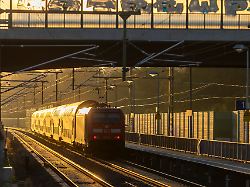Routes closed for months
The railways and the federal government present a renovation plan for the rail network
September 15, 2023, 12:13 p.m
Listen to article
This audio version was artificially generated. More info | Send feedback
Diversions and replacement bus services – rail travelers will have a lot to expect in the next few years. Dozens of heavily used routes are being closed one after the other so that the tracks can be replaced. At a summit, the railways and the federal government present the schedule.
The federal government wants to make Deutsche Bahn’s ailing rail network fit for the future with a renovation worth billions. Despite the tight budget situation, around 40 billion euros should be made available additionally by 2027, said Federal Transport Minister Volker Wissing at the 2023 rail summit in Frankfurt. The rail infrastructure has been neglected for decades and pushed to its absolute limits. This is no longer acceptable and is also not the claim of Germany as a location. The FDP politician appealed to the railways and the construction industry to tackle the renovation together: “The money is there, we can get started.” The railway is important as a climate-friendly mode of transport.
The investment package is the largest and most comprehensive infrastructure program for the rail network and stations since the rail reform in 1994. The Ministry of Transport and Railways have identified the heavily used routes to be renovated and prioritized them by 2030. However, there will then be longer and extensive route closures with replacement traffic.
The sections should generally be completely closed for five months for the work. This involves extensive diversions for train traffic, which should then run undisturbed for years. The railway has to organize extensive replacement services and diversions. In the end, after the general renovation of 4,000 kilometers of rail, there will be a “high-performance network” covering around 9,000 kilometers. In total, the network covers around 34,000 kilometers.
40 sections will be renewed
The Frankfurt/Main – Mannheim route will start in 2024, followed by the Emmerich – Oberhausen and Hamburg – Berlin corridors in 2025. The renovation of the last of the 40 corridors, Mannheim – Karlsruhe, should begin in 2030, said Wissing. At the Frankfurt “Rail Summit” with the construction and railway industries, the further order of the rail sections was presented. In 2026, the Cologne-Hagen, Nuremberg-Reichswald-Regensburg, Troisdorf-Koblenz and Koblenz-Wiesbaden routes will be started, among others.
The Ministry of Transport provides the funds necessary for investments in rail infrastructure. In the draft for the 2024 budget and the financial planning until 2027, an additional 11.5 billion euros are earmarked for rail, and a further 12.5 billion euros will come from the climate and transformation fund. The railway itself is contributing three billion euros. A further 12.5 billion euros are to be made available through an equity increase, as Wissing explained. Together, that’s a total of almost 40 billion euros. The railway has estimated the need at around 45 billion euros and the remaining funds will be built up in the coming years.
The need is great. In 2022, almost one in three long-distance rail travelers reached their destination at least 15 minutes late. Only 70.6 percent of passengers arrived at their destination less late, according to a response from the Federal Ministry of Transport to a representative’s office. “Traveller punctuality” has deteriorated by ten percentage points from 2021 to 2022. In 2017, a good 86 percent of passengers arrived at their destination less than 15 minutes late. From the critics’ point of view, the background is the lack of investment in the rail infrastructure for decades.
In order to implement the renovation projects, it is planned to found a new, public-interest-oriented infrastructure company called “InfraGo” under the umbrella of the DB Group. The sub-companies DB Netz and DB Station and Service are to be merged into this at the turn of the year. The purpose of the design is that the federal funds provided flow exclusively into the infrastructure and not into driving operations. Critics had called for the network to be completely separated from the railway company.
